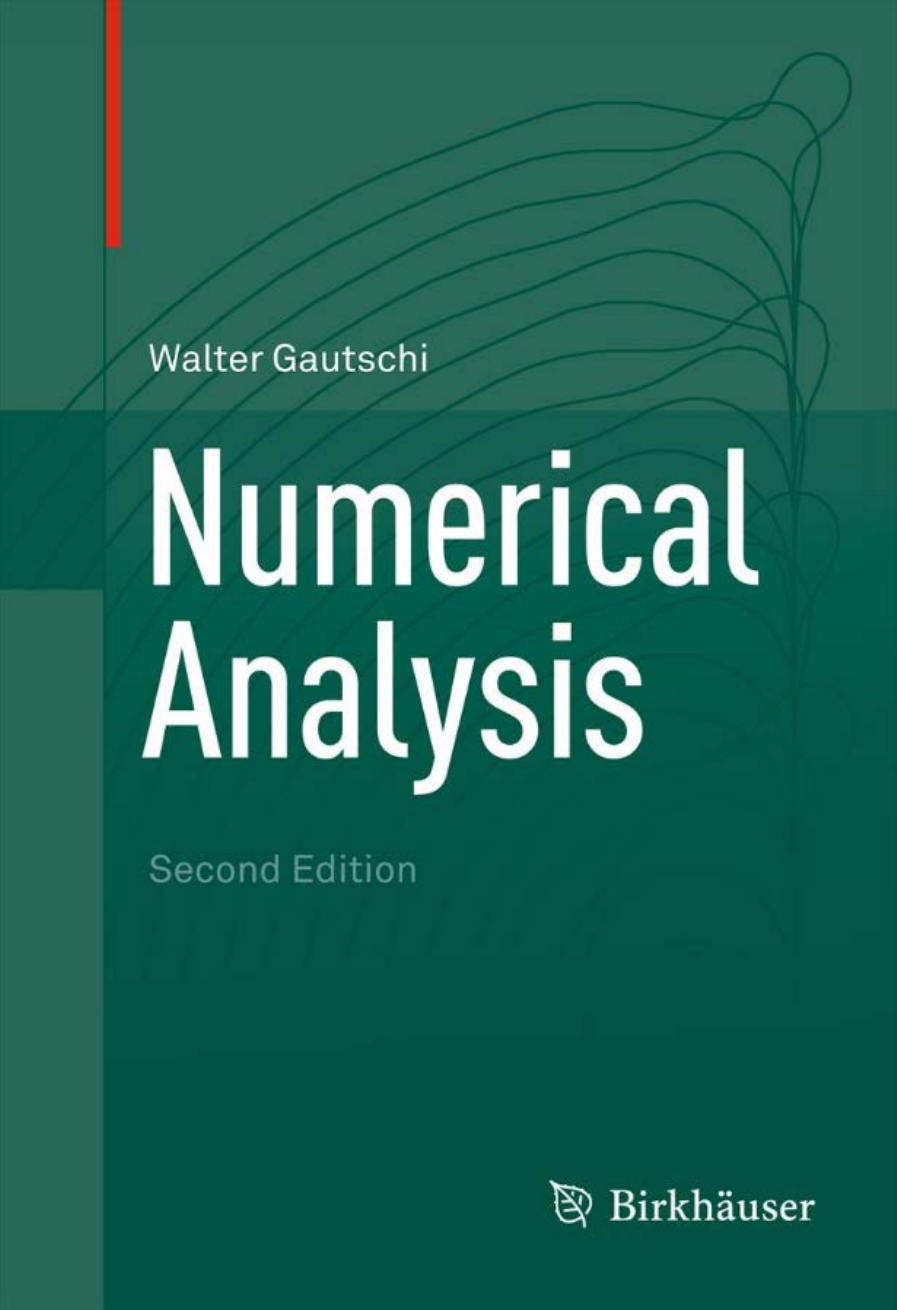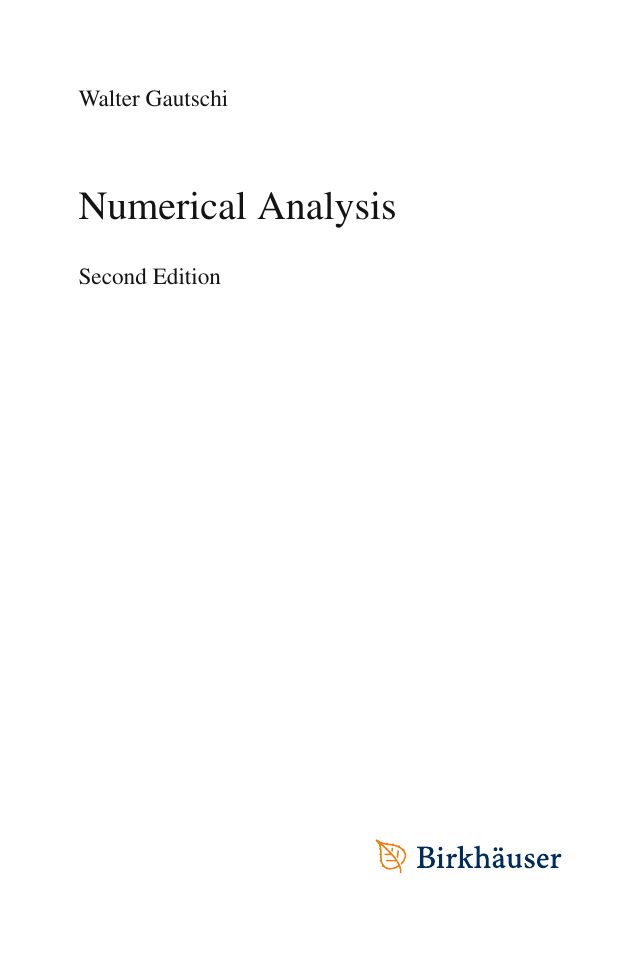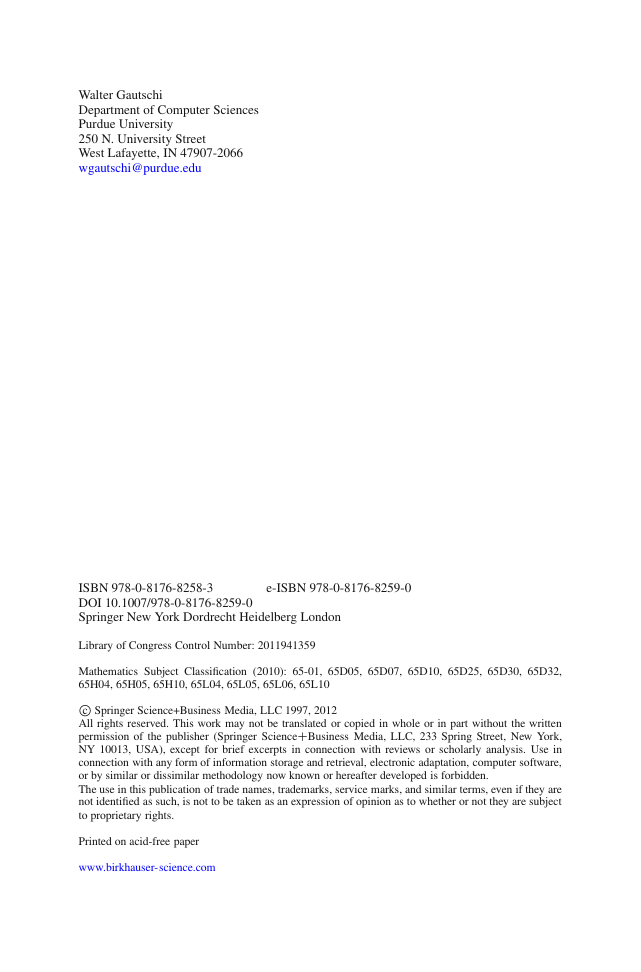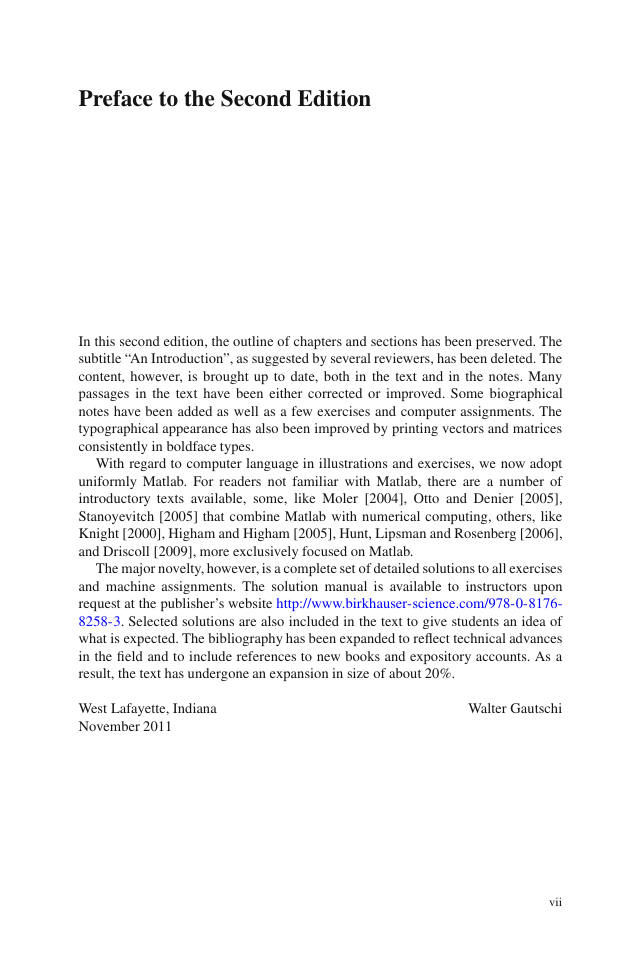GetFullPageImage
front-matter
Numerical Analysis
Preface to the Second Edition
Preface to the First Edition
Contents
Prologue
P1 Overview
P2 Numerical Analysis Software
P3 Textbooks and Monographs
P3.1 Selected Textbooks on Numerical Analysis
P3.2 Monographs and Books on Specialized Topics
P4 Journals
fulltext
Chapter 1: Machine Arithmetic and Related Matters
1.1 Real Numbers, Machine Numbers, and Rounding
1.1.1 Real Numbers
1.1.2 Machine Numbers
1.1.2.1 Floating-Point Numbers
1.1.2.2 Fixed-Point Numbers
1.1.2.3 Other Data Structures for Numbers
1.1.3 Rounding
1.2 Machine Arithmetic
1.2.1 A Model of Machine Arithmetic
1.2.2 Error Propagation in Arithmetic Operations:Cancellation Error
1.3 The Condition of a Problem
1.3.1 Condition Numbers
1.3.2 Examples
1.4 The Condition of an Algorithm
1.5 Computer Solution of a Problem; Overall Error
1.6 Notes to Chapter 1
Exercises and Machine Assignments to Chapter 1
Exercises
Machine Assignments
Selected Solutions to Exercises
Selected Solutions to Machine Assignments
fulltext(1)
Chapter 2: Approximation and Interpolation
2.1 Least Squares Approximation
2.1.1 Inner Products
2.1.2 The Normal Equations
2.1.3 Least Squares Error; Convergence
2.1.4 Examples of Orthogonal Systems
2.2 Polynomial Interpolation
2.2.1 Lagrange Interpolation Formula: Interpolation Operator
2.2.2 Interpolation Error
2.2.3 Convergence
2.2.4 Chebyshev Polynomials and Nodes
2.2.5 Barycentric Formula
2.2.6 Newton's Formula
2.2.7 Hermite Interpolation
2.2.8 Inverse Interpolation
2.3 Approximation and Interpolation by Spline Functions
2.3.1 Interpolation by Piecewise Linear Functions
2.3.2 A Basis for S10 (Δ )
2.3.3 Least Squares Approximation
2.3.4 Interpolation by Cubic Splines
2.3.5 Minimality Properties of Cubic Spline Interpolants
2.4 Notes to Chapter 2
Exercises and Machine Assignments to Chapter 2
Exercises
Machine Assignments
Selected Solutions to Exercises
Selected Solutions to Machine Assignments
fulltext(2)
Chapter 3: Numerical Differentiation and Integration
3.1 Numerical Differentiation
3.1.1 A General Differentiation Formula for Unequally Spaced Points
3.1.2 Examples
3.1.3 Numerical Differentiation with Perturbed Data
3.2 Numerical Integration
3.2.1 The Composite Trapezoidal and Simpson's Rules
3.2.2 (Weighted) Newton–Cotes and Gauss Formulae
3.2.3 Properties of Gaussian Quadrature Rules
3.2.4 Some Applications of the Gauss Quadrature Rule
3.2.5 Approximation of Linear Functionals: Methodof Interpolation vs. Method of UndeterminedCoefficients
3.2.6 Peano Representation of Linear Functionals
3.2.7 Extrapolation Methods
3.3 Notes to Chapter 3
Exercises and Machine Assignments to Chapter 3
Exercises
Machine Assignments
Selected Solutions to Exercises
Selected Solutions to Machine Assignments
fulltext(3)
Chapter 4: Nonlinear Equations
4.1 Examples
4.1.1 A Transcendental Equation
4.1.2 A Two-Point Boundary Value Problem
4.1.3 A Nonlinear Integral Equation
4.1.4 s-Orthogonal Polynomials
4.2 Iteration, Convergence, and Efficiency
4.3 The Methods of Bisection and Sturm Sequences
4.3.1 Bisection Method
4.3.2 Method of Sturm Sequences
4.4 Method of False Position
4.5 Secant Method
4.6 Newton's Method
4.7 Fixed Point Iteration
4.8 Algebraic Equations
4.8.1 Newton's Method Applied to an Algebraic Equation
4.8.2 An Accelerated Newton Method for Equations with Real Roots
4.9 Systems of Nonlinear Equations
4.9.1 Contraction Mapping Principle
4.9.2 Newton's Method for Systems of Equations
4.10 Notes to Chapter 4
Exercises and Machine Assignments to Chapter 4
Exercises
Machine Assignments
Selected Solutions to Exercises
Selected Solutions to Machine Assignments
fulltext(4)
Chapter 5: Initial Value Problems for ODEs: One-Step Methods
5.1 Examples
5.2 Types of Differential Equations
5.3 Existence and Uniqueness
5.4 Numerical Methods
5.5 Local Description of One-Step Methods
5.6 Examples of One-Step Methods
5.6.1 Euler's Method
5.6.2 Method of Taylor Expansion
5.6.3 Improved Euler Methods
5.6.4 Second-Order Two-Stage Methods
5.6.5 Runge–Kutta Methods
5.7 Global Description of One-Step Methods
5.7.1 Stability
5.7.2 Convergence
5.7.3 Asymptotics of Global Error
5.8 Error Monitoring and Step Control
5.8.1 Estimation of Global Error
5.8.2 Truncation Error Estimates
5.8.3 Step Control
5.9 Stiff Problems
5.9.1 A-Stability
5.9.2 Padé Approximation
5.9.3 Examples of A-Stable One-Step Methods
5.9.4 Regions of Absolute Stability
5.10 Notes to Chapter 5
Exercises and Machine Assignments to Chapter 5
Exercises
Machine Assignments
Selected Solutions to Exercises
Selected Solutions to Machine Assignments
fulltext(5)
Chapter 6: Initial Value Problems for ODEs: Multistep Methods
6.1 Local Description of Multistep Methods
6.1.1 Explicit and Implicit Methods
6.1.2 Local Accuracy
6.1.3 Polynomial Degree vs. Order
6.2 Examples of Multistep Methods
6.2.1 Adams–Bashforth Method
6.2.2 Adams–Moulton Method
6.2.3 Predictor–Corrector Methods
6.3 Global Description of Multistep Methods
6.3.1 Linear Difference Equations
6.3.1.1 Homogeneous Equation
6.3.1.2 Inhomogeneous Equation
6.3.2 Stability and Root Condition
6.3.3 Convergence
6.3.4 Asymptotics of Global Error
6.3.5 Estimation of Global Error
6.4 Analytic Theory of Order and Stability
6.4.1 Analytic Characterization of Order
6.4.2 Stable Methods of Maximum Order
6.4.3 Applications
6.5 Stiff Problems
6.5.1 A-Stability
6.5.2 A(α)-Stability
6.6 Notes to Chapter 6
Exercises and Machine Assignments to Chapter 6
Exercises
Machine Assignments
Selected Solutions to Exercises
Selected Solutions to Machine Assignments
fulltext(6)
Chapter 7: Two-Point Boundary Value Problems for ODEs
7.1 Existence and Uniqueness
7.1.1 Examples
7.1.2 A Scalar Boundary Value Problem
7.1.3 General Linear and Nonlinear Systems
7.2 Initial Value Techniques
7.2.1 Shooting Method for a Scalar Boundary Value Problem
7.2.2 Linear and Nonlinear Systems
7.2.3 Parallel Shooting
7.3 Finite Difference Methods
7.3.1 Linear Second-Order Equations
7.3.2 Nonlinear Second-Order Equations
7.4 Variational Methods
7.4.1 Variational Formulation
7.4.2 The Extremal Problem
7.4.3 Approximate Solution of the Extremal Problem
7.5 Notes to Chapter7
Exercises and Machine Assignments to Chapter 7
Exercises
Machine Assignments
Selected Solutions to Exercises
Selected Solutions to Machine Assignments
back-matter
References
Index
















 2023年江西萍乡中考道德与法治真题及答案.doc
2023年江西萍乡中考道德与法治真题及答案.doc 2012年重庆南川中考生物真题及答案.doc
2012年重庆南川中考生物真题及答案.doc 2013年江西师范大学地理学综合及文艺理论基础考研真题.doc
2013年江西师范大学地理学综合及文艺理论基础考研真题.doc 2020年四川甘孜小升初语文真题及答案I卷.doc
2020年四川甘孜小升初语文真题及答案I卷.doc 2020年注册岩土工程师专业基础考试真题及答案.doc
2020年注册岩土工程师专业基础考试真题及答案.doc 2023-2024学年福建省厦门市九年级上学期数学月考试题及答案.doc
2023-2024学年福建省厦门市九年级上学期数学月考试题及答案.doc 2021-2022学年辽宁省沈阳市大东区九年级上学期语文期末试题及答案.doc
2021-2022学年辽宁省沈阳市大东区九年级上学期语文期末试题及答案.doc 2022-2023学年北京东城区初三第一学期物理期末试卷及答案.doc
2022-2023学年北京东城区初三第一学期物理期末试卷及答案.doc 2018上半年江西教师资格初中地理学科知识与教学能力真题及答案.doc
2018上半年江西教师资格初中地理学科知识与教学能力真题及答案.doc 2012年河北国家公务员申论考试真题及答案-省级.doc
2012年河北国家公务员申论考试真题及答案-省级.doc 2020-2021学年江苏省扬州市江都区邵樊片九年级上学期数学第一次质量检测试题及答案.doc
2020-2021学年江苏省扬州市江都区邵樊片九年级上学期数学第一次质量检测试题及答案.doc 2022下半年黑龙江教师资格证中学综合素质真题及答案.doc
2022下半年黑龙江教师资格证中学综合素质真题及答案.doc